How to become a unicorn or crackdown on conversion myths

Conversion rate is a key point in online advertising. If views do not turn into clicks and clicks into money, then why the hell should we invest money in advertising? But what is a “good conversion” - 3, 5 or 10%?
Wordstream experts analyzed several thousand landing pages and campaigns in Google Adwords, and found that some advertisers receive 2-3 times more conversions than the average data in the industry. What does it depend on: on the “straightness” of the marketer’s hands, the size of the budget or the lunar calendar? What is unusual about leaderboard campaigns that other players don’t do?
')
Firstly, it is connected with the stereotypes of thinking - business owners put someone else's experience into the basis of their own advertising campaigns. Opinions of experts, best practices, copying competitors.
Wordstream founder Larry Kim compares what experts say with belief in talismans. Brilliant and cute from the outside, but empty in essence. Consider: marketing gurus say almost the same thing, your competitors listen to them. And if everyone does the same thing, how are you going to stand out?
Secondly, most of the techniques revolve around optimizing the CTA buttons, the number of fields in the application form, the quality of images and other micro actions. Occasionally they “shoot out” with a 40-50% rise in conversion. Most often it is 10-15%. Yes, the constant tests of the elements of the landing page give the result, but it is unlikely that you will go beyond the limits of the “hospital average” indicators.
Below is the statistics of one of the tests from the discharge of microconversion optimization:
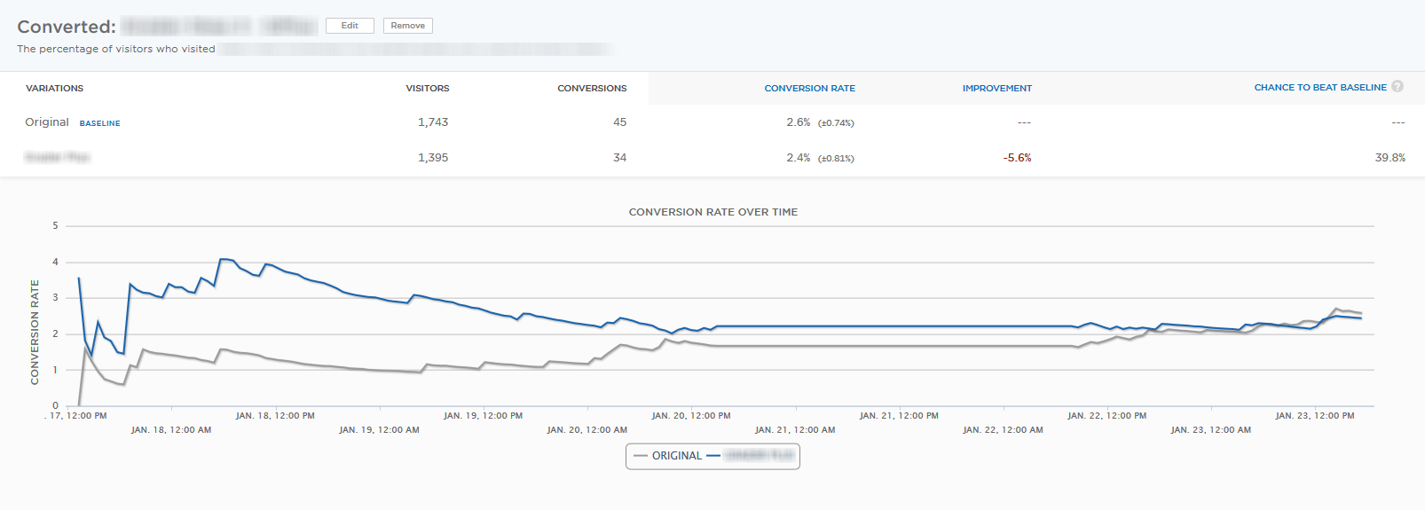
The gray line is the original, the blue line is the test version of the page. In a day, the breakdown of the conversion of the test version is almost 3 times. Cool! And then - the pain and disappointment (((
After 3 days, the conversion of the original "catches up", and a week ahead of the "upstart" by tenths of a percent. And so ends most of the a / b tests with buttons, forms, pictures.
Larry Kim calls this approach "moving chairs on the Titanic."
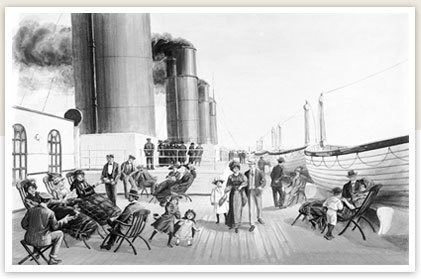
Micro actions are useless, the template gap is necessary. To get started, Wordstream research data:

About ¼ of all accounts have <1% conversion; The middle part of the sample is 2.35%; Leaders - 5.31%; Top> 11.45%.
* The calculations imply the conversion of landing pages, Google Adwords accounts (on one account there can be> 1 landing page, more than 1 advertising campaign).
In quantitative terms, it looks like this:

If your conversion is at the level of 5%, then you are already ahead of 65% of advertisers by 2 times, while the Top “unicorns” with a 5-fold advantage is not an anomaly, but a natural result.
But the conversion statistics by industry:

Unfortunately, we did not find similar information on Runet. If you have any statistics, share in the comments.
How to become a "unicorn"
Larry Kim recommends doing 5 things:
1. Change offer (value proposition)
Recall the landing pages you encountered. How much do they differ within one niche? Most often, these are commonplace “building”, “delivering”, “installing” with calls to get a free consultation, sign up for a measurement in “national economic” topics or install a demo version in the IT sphere. Business in the very first step sells its product.
The more complex the product, the longer the chain of touches. And the first step, the transition of the visitor to the lead should be as simple as possible. To do this, make the least burdensome proposal.
Wordstream made the so-called "advertising grader" by Google Adwords. The user receives a comprehensive report on the effectiveness of his account - from the analysis of semantics to the text of ads. Free, for 1 minute, in exchange for email.
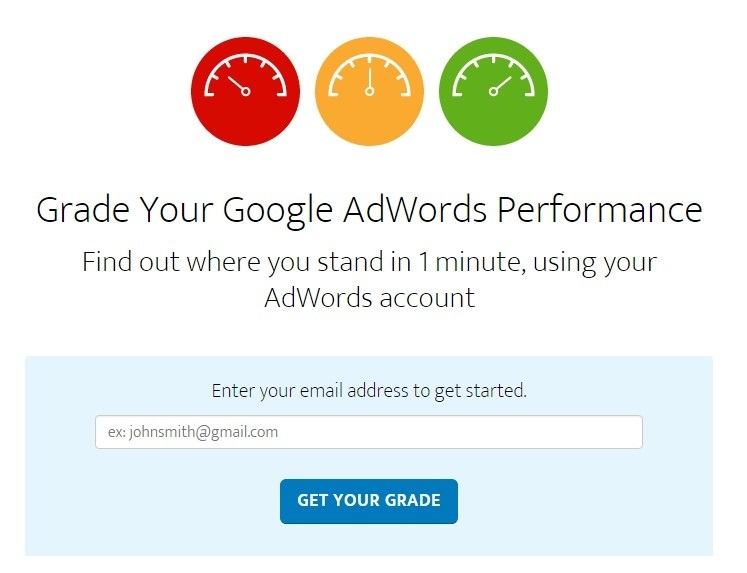
In addition, the conversion of the offer is strongly influenced by traffic sources, but more on that later.
2. Change the sequence of actions
This is relevant when filling out forms for complex IT products and financial services where a large amount of information is required.
When the user sees this form:

He reacts like Mr. Bean:

By the way, this form “captured” visitors of the PDFZilla application (converting PDF files to other formats).
On the new landing page, the developers have changed the sequence of actions. Now users first install the application, and then register:
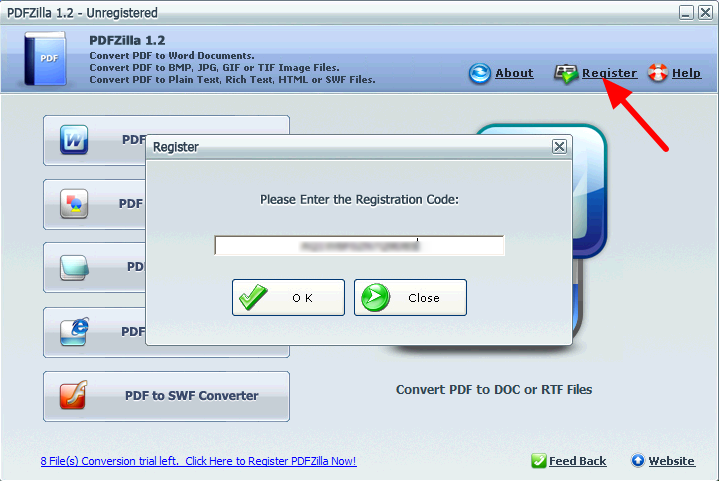
The task is to identify the obstacles in the path of users to the target action. Analyze what stops them, which causes doubts.
3. Set up remarketing (retargeting)
Yes, he is working. According to Larry Kim, proper retargeting increases the impact of an advertising campaign by 55-60%.
4. Test 10 landing pages to find 1 effective
Tests will show effective options and allow you to filter the "slag". It is not necessary to spend efforts that does not give return. However, many experts focus only on the target traffic. A person wants to install plastic windows - we offer him installation of windows. Discounted or some other "bun" to attract.
Normal strategy, only one minus: expensive. Competition rolls over, auction "overheated", the price of a click increases.
And what if there are very few target requests, or are they super expensive, as in window subjects? How to be innovative products (mobile applications, IT-development, etc.)? There are no target requests at all!
Well, who, pray tell, will look for "Application for preserving children's vision while watching a computer"? By the way, not so long ago, developers of such an application came to us with the problem of setting up Yandex Direct in particular, and of promotion in general.
What came of it - read the article "3 ways to get customers from contextual advertising at the price of a business card . "
5. Spit on a conversion
Larry Kim put it even cooler: "F ... k The Conversion". How so? Conversion is not an easy indicator and can be misleading.
We recommend to pay attention to 3 points:
Consider traffic sources
Even a strong offer will drown in a stream of “dirty” traffic, when users come to the landing page with a weak interest in the product or even by untargeted requests. This is on the conscience of not very competent traffic specialists, and we will consider a more common option.
Once we tested the headlines on the landing page of a fitness club and received the following data:
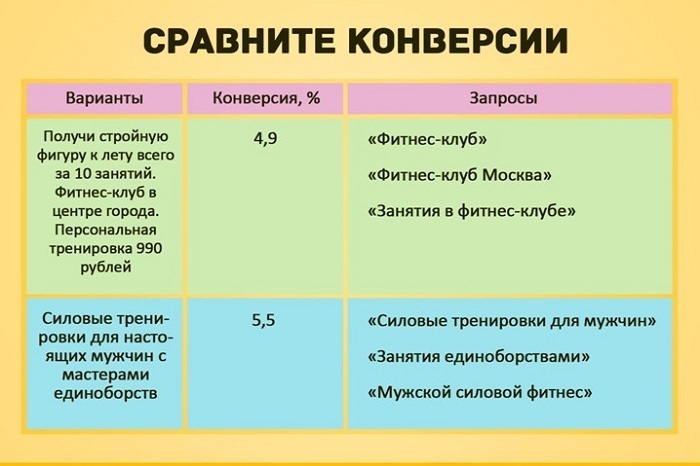
The first heading is stronger: specific benefits and a call to action, value proposition. In the second version - “just” the title, a statement of fact, what the company does. But all the logic is turned upside down, depending on the sources of traffic.
The primitive headline gave more conversions because the page responds to direct requests. A person wants to do strength training, which he sees in the proposal. Clearly hit the need.
And in the second case - vague requests. Both men and girls come along them. And, perhaps, a person is not interested in a slim figure, but, on the contrary, how to gain weight, pump up biceps, etc.
The problem is that no one digs so deep. There is a pool of requests, there is more or less tolerable (for a manager or a client) conversion of a page into an application. What else does? In fact, the work "at depth" can give amazing results if you need to take off to the level of "unicorns".
In Yagla, we give our offer for every need of the user. On the same page. The need to "pull out" of requests.
Example from the dealership case:
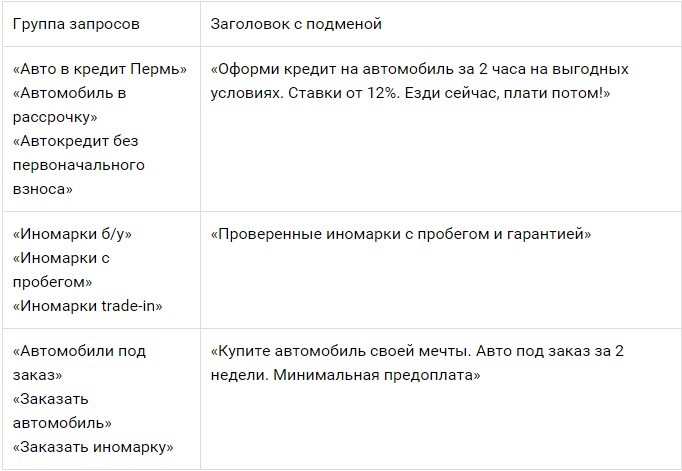
Grouping from 5 to 30 phrases, and it works great.
Consider external factors
In addition to purely internal factors, there are seasonal variations in the quantity and quality of traffic (holiday season, holidays), media publications, advertising, and even the weather at a specific time.
One of the companies for the delivery of pizza caught the relationship - when it rains, the number of orders jumps sharply. In Google Adwords, they set up a display of special offers in the spirit of “Enjoy pizza while it's raining.” This feature has increased the ROI of the entire advertising campaign by 25%.
And, on the contrary, some things should be neglected. For example, you talked about the federal television channel. Or your site got in the TOP ranking on the untwisted resource. Attendance soared, and the conversion collapsed. Because the audience came not targeted, from the category of "pozyrit".
Measure ROI Optimization
Conversion for the conversion does not make any sense. How many users filled out the form and sent applications - not as important as the number of buyers in the end. With a 10% conversion in the bid, you may have a 1% conversion in the sale. See what happens on the “lower” floors of the sales funnel.
For example, the agency Popcorn Metrics describes the case when one of the page variants in the a / b test was ahead of the "competitors" by 40% (conversion to registration). But at the final stage, the conversion leader (in the installation of the application) lost 2.5 times (!).
Count profits, not registrations; business conversion, not website conversion.
PS Share in the comments your experience and what you think about all this.
Image: Dark_sheirena
Source: https://habr.com/ru/post/296524/
All Articles